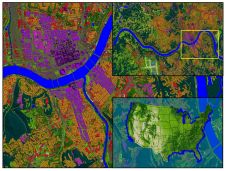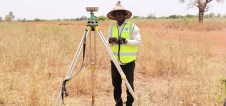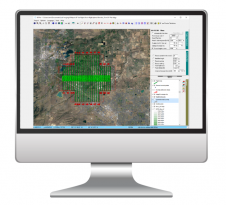Focus on Essential Data
Improving Plan-making by Selective Collection of Geo-information
How much of the data collected by planners is actually used in a plan-making exercise? "Very little," a planner will discreetly reply. Only 60% of data actually become input for plan making. Why then do planners collect so much data? Habit! Bound by traditions! And this whilst huge amounts of time and other resources are spent on collecting and analysing the same data, which in turn delays the start of the planning process, sometimes by several years. Differentiation, says this author, between essential and desirable data should provide the answer to this waste of resources.
Planners everywhere collect a huge amount of data and information for planning exercises at various levels. This data is collected from many sources and often comes in a variety of formats, scales, detail and spatial and temporal resolution. The data covers seemingly unrelated fields, such as demography, geography, economics, sociology, physiography, soils, hydrology, vegetation, forests, and transportation. The huge amounts of time and other resources spent on collecting and analysing this data lead to two problems: halting or lack of planning in the development process resulting in unauthorised and undesirable development, and data becoming quickly outdated, often by the time of use.
Too Much Wrong Stuff
All the techniques taught in Schools of Planning and everywhere practised suggest collection of data on almost everything and anything imaginable. The thought of what not to collect simply does not exist. And this decision is not easy, because planning is concerned with all aspects of land and people, and according to the traditions all that is available should be collected. What is wrong in having too much data? Besides being a waste of time, energy, human and financial resources, the database becomes of unmanageable size, requiring large storage space, memory and processing time. Dissemination of data from one location to another will also take long, and this when data sharing becomes the buzzword.
选择ive Collection
减少数据采集成本和时间,minimise database redundancy, keep database size small and start planning early, the best option would be to concentrate on essential data. This would be easily available data that is reliable and accurate and comes from an authentic source in a desired format. The planning exercise cannot be undertaken in the absence of any of the essential data. More importantly, crucial decisions need to be made during the plan-preparing exercise. Much data is either unavailable or unusable due to lack of accuracy, reliability or inappropriate format. Pilot studies undertaken by various experts for the National Urban Observatory (NUO) programme of the Town and Country Planning Organisation (TCPO) of the Ministry of Urban Development, Government of India support this finding. However, by focusing on essential data the plan-making exercise can start early, and desirable data - any that does not affect basic plan-making - can follow and be incorporated as and when available. Desirable data may have one or more of the following characteristics:
- not readily available
- source other than preferred
- reliability and authenticity of source doubtful
- format other than preferred
- updates have been at long intervals.
The criteria for classification may not be highly scientific or easy to apply but, with a little experience and some case studies, broad guidelines could be worked out.
Data Sharing
Classifying data into essential and desirable will also lead to better data standardisation and hence better comparison between datasets. Given essential data, aggregation of data from lower levels to higher levels will also be easier. It will keep the database simple; easy to comprehend and use by less technically qualified staff at remote locations. It will also generate confidence among users. Importantly, data sources would be reduced to a minimum. In the case of planning for the layout, area and neighbourhood levels in Delhi, about 90% of the essential data could be obtained from just two sources: the newly introduced Property Tax Returns (with minor modifications) and the Ration Card currently being computerised. Since the information on both is generated at individual property and individual household level, respectively, and is stored, maintained and updated by responsible authorities, no need exists for data collection by a planner; sharing of data with the planning authority would be sufficient. These findings should act as an eye-opener for planners, as the pre-planning requisites could be made so easy, simple, handy and comfortable that the planning stage could reach new heights.
Reducing data sources to a minimum would also save data-acquisition time, simplify sharing and co-ordination, and reduce the complexities of a large database.
Concept Acceptance
The concept of essential data and desirable data has already been around for some time. It found reference in the proceedings of the working groups for the National Urban Information System (NUIS) project documentation and the related workshops. The concept found acceptance in recommendations adopted at the NUIS Workshop (ISRO-TCPO, 2004; ISRO: Indian Space Research Organisation). The recommendation for NUIS Standard reads: Content standard for 3 levels of NUIS database must be clearly listed/stated. The content can be categorised into most essential and desirable, and efforts to be made to develop a minimum-level database at the respective levels. The recommendation for National Urban Data Bank and Indicators (NUDBI) concept states: The NUDBI parameters need to be prioritised and initially characterised into those that are essential, desirable and optional; the approach of developing a minimum level of NUDBI for each city/town is essential. In principle, the concept can be extended to similar large databases such as National Spatial Data Infrastructure (NSDI), NUDBI, and District Information System of the National Informatics Centre (DISNIC).
Changing Habits
必须注意,数据库结构flexible enough to take the desirable data as and when available, yet the system should be able to work when the desirable data is not available. It is not a difficult task to accomplish. It only requires a little debate, experimentation and willingness to change our habits!
Acknowledgement
Studies carried out by Akshima Dogra and Swati Khanna, School of Planning and Architecture, New Delhi provided important input for this article.
Make your inbox more interesting.Add some geo.
Keep abreast of news, developments and technological advancement in the geomatics industry.
Sign up for free
























